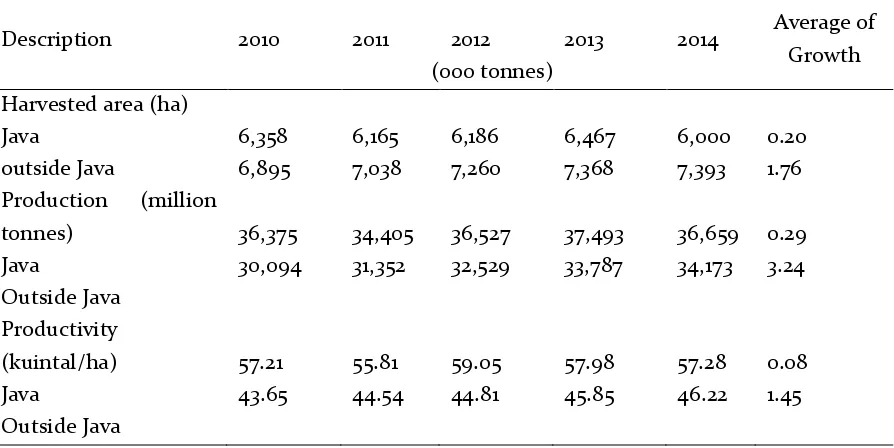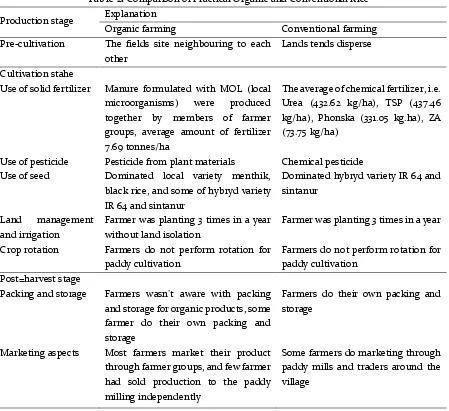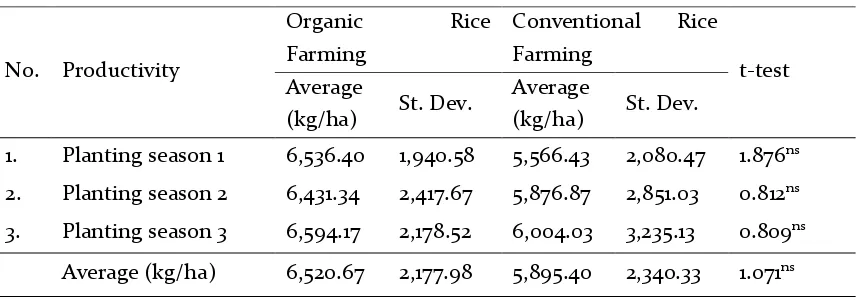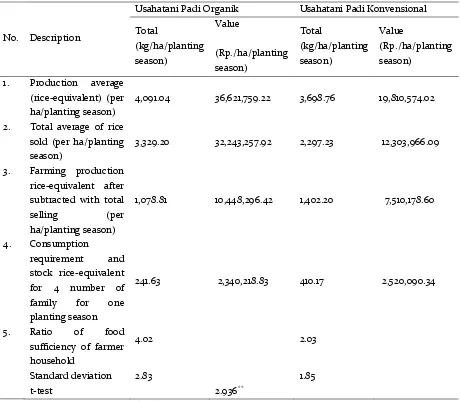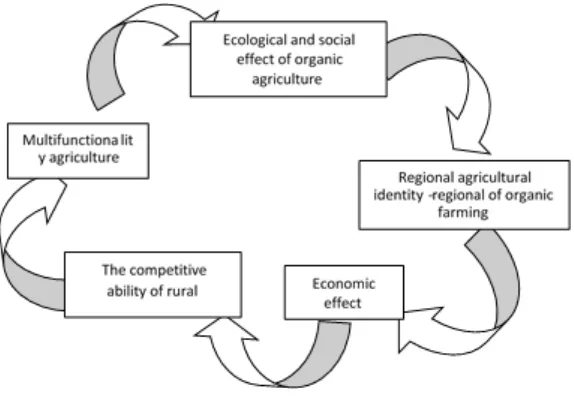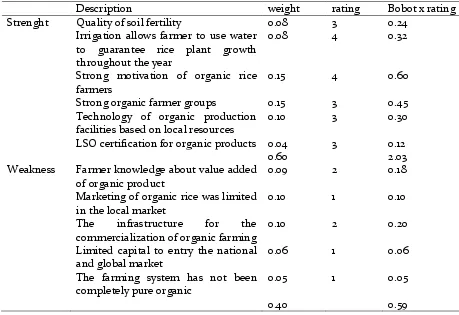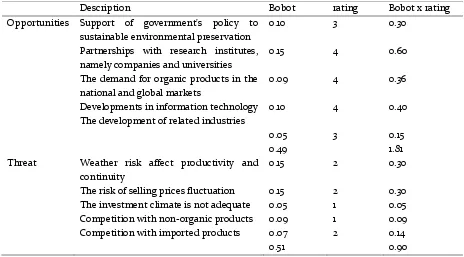JEJAK
Journal of Economics and Policy http://journal.unnes.ac.id/nju/index.php/jejak
Appreciation to Organic Agriculture Function: Case Study of Rice
Farming
Tinjung Mary Prihtanti1
1Agriculture and Business Faculty, Satya Wacana Christian University, Indonesia
Permalink/DOI:http://dx.doi.org/10.15294/jejak.v9i2.7630
Received: April 2016; Accepted: April 2016; Published: March 2016
Abstract
Agricultural activities are not only producing the visible (tangible) output in the form of food but also the non-visible output (non-marketable goods/non-tangible services). Non-visible output refers to a multifunctionality to supply food to ensure the food sufficiency of farmer household and job opportunities at rural area. The article aims to compare the capability of organic rice farming to conventional, to ensure the food sufficiency of farmer household, the economic value of rice farming to produce food, and the economic estimation of rice farming to its function as an job opportunities. The data for the research is collected in Gentungan Village, Mojogedang District, Karanganyar Regency during the crop year of 2015. In order to study the differences of two rice farming systems, the total of 60 farmers, 30 farmers are dealing with organic farming and other 30 farmers from conventional farming, are subjected for the interview in this research. The results found that the food security of organic farming is higher than conventional farming. The organic rice farming gives the economic value as the food producing and the labor-absorbing function in the study area is higher than the conventional farming.
Keywords: rice farming,organic, conventional, economic value of food producing, job opportunities
How to Cite: Prihtanti, T. (2016). Appreciation to Organic Agriculture Function: Case Study of Rice
Farming. JEJAK: Jurnal Ekonomi Dan Kebijakan, 9(2), 279-296. doi:http://dx.doi.org/10.15294/jejak.v9i2.7630
© 2016 Semarang State University. All rights reserved
Corresponding author :
Address: Jl. Diponegoro 52-60 Salatiga 50711 E-mail: [email protected]
INTRODUCTION
In Indonesia, rice production is considered as the most important crop in agricultural sector like the neighboring countries in Southeast Asia. As the strategic commodities, rice has an important position to maintain its functions, either as staple food provider, the main employment supplier, industrial raw inputs supplier, and even become a source of foreign exchange. Politically, the government put rice as the main target of economic development. Therefore, since the 60s, there were many national programs to improved the rice production, considering the increasing number of Indonesian population leading to the increasing demand on rice consumption each year. Java still plays an important role as the supplier of 60% of national rice production, so that technological innovation aggressively pursued to maintain and improve productivity. In the Ministry of Agriculture Strategic Plan 2015-2019, it had targeted the sustainable self-sufficiency in the rice crop as one of the targets of agricultural development achievement. To increase the rice farming
productivity, especially in Java, the
technological innovation continues to be encouraged, but these efforts are threatened by the deforestation of wetland due to the transfer of functions and decrease in the carrying capacity of the land and the environment due to the contamination of soil, water and the environment by chemicals inputs in rice farming , Therefore, the practice of rice cultivation in addition to providing the economic benefits for farmers also contains the ecological risks that have the potential to hinder the achievement of economic goals short and long term, not only for farmers but also for the surrounding community.
According to De Vries (2000), the agricultural practices have always interlinked on thr role and function each other, between the economic, environmental, and social. The role and functions linkage of the agricultural sector is the concept of multifunctionality of agriculture. Matsumoto (2002 in Concepcion et al, 2006) proposed that agricultural activities do not only produce visible (tangible) in the form of food and fiber but also produce the visible (non-marketable goods / non-tangible services), which is referred to as a multifunctionality of
agriculture (MFA). Several researches
examined the forms of agriculture that are considered to maximizing the social function of agriculture, among others, Liu et al (2010) analyzed the multifunction of two main areas of the rice cultivation in Taiwan, Ohe (2007) examined the functions arising from the diversification of agriculture, and Hocevar and Juvancic (2006) investigated the function of the area that has not been defined.
The value of direct benefits (direct use value) obtained from the farming activities, which can be felt by people, usually is not measured empirically (unpriced benefit) including those that are the availability of food and job opportunities. Many countries that concerns with agriculture function to
ensure the food security and the
environmental sustainability review to
quantify many positive externalities value of
agriculture. Some multifunctionality
Table 1. Harvested Area, Production and Productivity of Rice in Java and outside Java Source: Ministry of Agriculture-year Strategic Plan 2015-2019
Note: (2014 Data ASEM), the production quality is dry unhusked rice (GKG)
In the Ministry of Agriculture Strategic Plan 2015-2019, it had targeted the sustainable self-sufficiency in the rice crop as one of the
targets of agricultural development
achievement. To increase the rice farming
productivity, especially in Java, the
technological innovation continues to be encouraged, but these efforts are threatened by the deforestation of wetland due to the transfer of functions and decrease in the carrying capacity of the land and the environment due to the contamination of soil, water and the environment by chemicals inputs in rice farming , Therefore, the practice of rice cultivation in addition to providing the economic benefits for farmers also contains the ecological risks that have the potential to hinder the achievement of economic goals short and long term, not only for farmers but also for the surrounding community. According to De Vries (2000), the agricultural practices have always interlinked on thr role and function each of the area that has not been defined. The value of direct benefits
(direct use value) obtained from the farming activities, which can be felt by people, usually is not measured empirically (unpriced benefit) including those that are the availability of food and job opportunities. other, between the economic, environmental, and social. The role and functions linkage of the agricultural sector is the concept of multifunctionality of agriculture. Matsumoto (2002 in Concepcion et al, 2006) proposed that agricultural activities do not only produce visible (tangible) in the form of food and fiber but also produce the visible (non-marketable goods / non-tangible services), which is referred to as a multifunctionality of
agriculture (MFA). Several researches
examined the forms of agriculture that are considered to maximizing the social function of agriculture, among others, Liu et al (2010) analyzed the multifunction of two main areas of the rice cultivation in Taiwan, Ohe (2007) examined the functions arising from the diversification of agriculture, and Hocevar and Juvancic (2006) investigated the function.
Description Average of
Many countries that concerns with agriculture function to ensure the food security and the environmental sustainability review to quantify many positive externalities value of
agriculture. Some multifunctionality
researches review the different parameters from one another. Rahmanto et al (2010) concluded that the public's understanding of the multifunctional wetland in general remains focused on the immediate benefits, especially its function as a food producer and employment.
Vassalos et al (2010), investigated various crops of vegetables and grains farming in Greece, and concluded that the organic farming is a form of agriculture that appreciates a multifunctionality and gives better economic performance agriculture than the conventional systems. Some studies have concluded the similar things (Cisilino and Madau (2007), Lopez and Requena (2006)), although it can be said that there are only few researches who tried to compare the multifunctional aspect between the organic agriculture and the conventional systems.
Various studies conclude that the economic performance of the organic farming is better than the conventional systems (Suhartini (2007), Prayoga (2005), Medina and Iglesias (2008)), but in Indonesia, the organic farming has not been attractive to many farmers. The intensive farming that relies on chemicals is still conducted by almost farmers in Indonesia
including the rice farmers because they are too long accustomed to the climate-oriented farming only pursue self sufficiency in rice since the green revolution. The government's attention to the organic farming through the "Go Organic 2010" has not gone well, it appears from the limited land area certified organic cultivation. Based on the SOEL survey in
Giovannucci (2005), it stated that the area of organic farming in Indonesia is about 40,000 hectares (0.09% against a broad or equal to 0.33% of the total rice area). The low interest of farmers in theorganic farming systems is also caused partly by the farmers’ belief on the low achievement of the organic farming, related to the achievement of productivity, efficiency, effectiveness, and profitability. The doubt of the farmers is supported by the rice farming studies that show different conclusion, some support each other, but some also obscure the potential for organic farming.
The research objective is to analyze the different functions of the organic farming systems with the conventional systems in supporting food sufficiency of farmers household, producing food, and providing employment, as well as the strategy of development of organic farming as a token of appreciation for a multifunctional, taking the case of rice farming.
RESEARCH METHODS
In order to study the differences of two rice farming systems, from the total of 60 farmers, 30 farmers are dealing with the organic farming and other 30 farmers from the conventional farming are subjected for the interview in this research. The organic rice farming is cultivation without chemical fertilizers and chemical pesticides, while the conventional rice farming is cultivation with chemicals inputs as a factor of production that is for the protection of plants and the various chemical fertilizers, either fully or half the normal dose.
Data Analysis
The descriptive statistic analysis is
applied to summarise the important
characteristics of the rice samples.
1. Food sufficiency of farmer household
According to Concepcion et al (2006), the availability of food supply is one category of the economic functions of the agriculture multifunctionality. Farming income for individual farmers is not included as a multifunctionality because it is valued at the market price. Referring to Sadikin and Subagyono (2008), the rice self-sufficiency is calculated by dividing the value of rice-equivalent farm production by rice consumption within one growing season. Based on the concept, food security, defined as the ratio, namely:
RKP = PUB / KSB
...(1) Note:
RKP = ratio of food sufficiency
PUB = the value of rice-equivalent farm production
KSB = rice consumption within one growing season
Criteria:
RKP = 1: subsistence RKP> 1: surplus
RKP <1: deficit
(Sadikin and Subagyono, 2008)
Rice Sufficiency Ratio (RSR) = 1 indicates adequate rice supply, RSR > 1 means farm household achieved rice surplus, and RSR <1 indicates defficiency of rice supply.
2. Economic value of food production
function
The economic calculation of farm
production function as a food supplier isi conducted by the approach of the following formula:
NFPP =
∑� �����
�=1 ... (2)
Note:
L = land area (ha)
Y = productivity (tons / ha)
H = the price of production (USD / ton) i = commodity indices
3. Economic value of employment absorber
The economic calculationn of the farm production function as job opportunities, according to the formula:
NFTK = ∑��=1 ����� ...(3)
Note:
L = land area (ha)
T = labor farm (HOK / ha) W = labor costs (USD / HOK)
This research describes the analysis of strengths, weaknesses, opportunities, and threats (SWOT) to formulate a strategy of development of the organic farming.
RESULTS AND DISCUSSION
Practice and Productivity Achievement of Organic Rice Farming
Table 2 shows the differences between the organic rice farming practice and the conventional one at the research location, which main difference is the use of fertilizers, pesticides, seeds, and marketing.
local seeds and are unconscious of the aspects of crop rotation, the irrigation management, and the treatment of post-harvest and marketing of their agricultural products. The organic rice farmers know about the source of nitrogen fertilizers and pesticides that should have been used, but they do not fully understand the seed that should be used in the concept of organic farming in which the the local seed should be pursued. It can be seen
that in their farming practices it still contained the organic banana planting hybrid seeds. Piadozo et al (2014) revealed that the rice farmers only low to medium level in terms of awareness on organic farming activity and the market for organic products.
The results of production performance of organic and conventional rice farming are shown in Table 3.
Table 2. Comparison of Practical Organic and Conventional Rice
Production stage Explanation
Organic farming Conventional farming Pre-cultivation The fields site neighbouring to each
other
Lands tends disperse
Cultivation stahe
Use of solid fertilizer Manure formulated with MOL (local microorganisms) were produced together by members of farmer groups, average amount of fertilizer 7.69 tonnes/ha
The average of chemical fertilizer, i.e. Urea (432.62 kg/ha), TSP (437.46 kg/ha), Phonska (331.05 kg.ha), ZA (73.75 kg/ha)
Use of pesticide Pesticide from plant materials Chemical pesticide Use of seed Dominated local variety menthik,
black rice, and some of hybryd variety IR 64 and sintanur
Dominated hybryd variety IR 64 and sintanur
Land management and irrigation
Farmer was planting 3 times in a year without land isolation
Farmer was planting 3 times in a year
Crop rotation Farmers do not perform rotation for paddy cultivation
Farmers do not perform rotation for paddy cultivation
Post=harvest stage
Packing and storage Farmers wasn’t aware with packing and storage for organic products, some farmer do their own packing and storage
Farmers do their own packing and storage
Marketing aspects Most farmers market their product through farmer groups, and few farmer had sold production to the paddy milling independently
Some farmers do marketing through paddy mills and traders around the village
Table 3. Productivity Rice Organic and Conventional
No. Productivity
Organic Rice
Farming
Conventional Rice
Farming
t-test Average
(kg/ha) St. Dev.
Average
(kg/ha) St. Dev.
1. Planting season 1 6,536.40 1,940.58 5,566.43 2,080.47 1.876ns
2. Planting season 2 6,431.34 2,417.67 5,876.87 2,851.03 0.812ns
3. Planting season 3 6,594.17 2,178.52 6,004.03 3,235.13 0.809ns
Average (kg/ha) 6,520.67 2,177.98 5,895.40 2,340.33 1.071ns
Source: primary data analysis (2015)
Description: pns = not significant at the 95% confidence level
Table 3 shows that the organic rice farming productivity is higher than the conventional farming. The achievement of both cropping systems in the research is
relatively higher than the average
productivity of the rice nationwide. The productivity of the planting season III is higher than any other season. The planting season is usually called the main planting season that is resulted a big harvest. The growing season II is called gadu gadu, and the dry growing season produces a small harvest. In dry season, there is a water irigation to boost the productivity and the grain quality is better than the rainy season because the disease tends to attack in the rainy season. The potential productivity of the organic farming systems based on several researches shows the high productivity, but several others showdifferent results. Lansink et al. (2002, in Sipilainen et al., 2008), showed the productivity of organic farming tends to be lower than conventional farming, on the other hand the productivity of capital, the land and labor are also likely to be low in the organic farming. Suhartini (2007) found that the productivity of semi-organic rice plants in every growing season is higher than the non-organic rice in Sragen, while the
semi-organic farming provides better benefits in improving the quality of the soil and biodiversity than the non-organic one.
Functions for Food Sufficiency
Food availability of farmer households is one category of the invisible economic function (Concepcion et al, 2006). According to Sadikin and Subagyono (2008), the measurement of food availability can be seen from the household subsistence level. The rice self-sufficiency is calculated by dividing the value of rice-equivalent farm production by the rice consumption within one growing season. Table 4 shows the calculation of the ratio of food sufficiency in the rice farming and its economic value using a level of selling prices at the farm level.
Table 4 shows that the rice cultivation with organic and conventional systems are able to meet the household food sufficiency, which is demonstrated by the value of food sufficiency ratio that is greater than one. The
excess of production over the rice
Table 4. Household Food Adequacy Ratio Rice Growers Organic and Conventional
No. Description
Usahatani Padi Organik Usahatani Padi Konvensional
Total
(kg/ha/planting season)
Value
(Rp./ha/planting season)
Total
(kg/ha/planting season)
Value
(Rp./ha/planting season)
1. Production average (rice-equivalent) (per ha/planting season)
4,091.04 36,621,759.22 3,698.76 19,810,574.02
2. Total average of rice sold (per ha/planting season)
3,329.20 32,243,257.92 2,297.23 12,303,966.09
3. Farming production rice-equivalent after subtracted with total selling (per ha/planting season)
1,078.81 10,448,296.42 1,402.20 7,510,178.60
4. Consumption
requirement and stock rice-equivalent for 4 number of family for one planting season
241.63 2,340,218.83 410.17 2,520,090.34
5. Ratio of food sufficiency of farmer household
4.02 2.03
Standard deviation 2.83 1.85
t-test 2.936**
Source: primary data analysis (2015)
Description: **: there is a difference between organic and conventional systems at the level of 95%
Supply of rice can fulfill the requirement of farmers at any time and can be sold. The behavior of rice farmers to save some stock is not only because the motivation of fulfilling the household consumption, but also for the social needs such as the tradition to "donate" in the wedding event. The higher the level of food sufficiency of household from own production is assumed that the family food needs will be stronger and it will support the family food needs independently. The level of household food security of the farmers applying organic rice farming system is higher than the conventional farming, it is because
the rice-equivalent production from the conventional farming is lower and there are more storage for the consumption and reserves. In other words, the behavior of the organic rice farmers to sell is higher than the conventional farmers.
Figure 1. Distribution of Paddy Farmers Food Adequacy Ratio by Farmer Households (Source: primary data, 2015)
The results of this research show that the farmers do not need to buy any additional rice to meet the domestic consumption needs. This is similar to the research of Arifin et al (2011) who mentioned that 824.44 kg/year rice for the household consumption by the rice farmers is enough, which is consumed 721.39 kg/year so that there are 103.05 kg of rice for the food reserve for next period. Such reserves are usually kept by the farmers and will be sold when they needs money for other needs. However, there is a behavior of the organic and conventional rice farmers who want to sell the whole of their products while they buy the cheaper price rice for daily consumption.
Economic Value as Food Producers The economic calculation of multi-functionality aspect of farm production is
conducted with the approach of the mathematical formula:
NFPP = ∑��=1 �����
Note:
L = land area (ha)
Y = productivity (kg / ha)
H = the price of production (IDR / kg) i = commodity indices
Rice in both areas of research is always planted at the wetland fields, which the organic rice farming productivity is about 6.52
tonnes/ha/planting season and 5.89
tonnes/ha/planting season for the rice cultivation with conventional systems. The land area of organic and conventional rice farming of all respondents in the research at Gentungan Village is about 75 900 m2 and 135 490 m2.
Table 5. Economic Value Function Food Producers of Organic and Conventional Rice in Study site
No. Farming systems Economic Value of Food Producers Function (Rp./ha/planting season) t-test
1. Organic rice farming 681,976,752,484.53
0.867ns 2. Conventional rice farming 285,406,897,218.38
Source: primary data analysis (2015)
Description: pns = not significant at the 95% confidence level
0% 10% 20% 30% 40% 50% 60% 70% 80% 90%
RKP > 1 RKP = 1 RKP < 1
%
Ratio of Food Sufficiency
The organic rice farming has an economic value as food producers of Rp 681 billions per hectare per planting season or Rp 2,045 billions/ha/year, which is higher than the conventional farming that is Rp 856 billions/ha/year. If there is a conversion of rice fields with organic systems in Gentungan Village, Karanganyar, the production value of agriculture and food production will result to higher lost than the value of lost of conversion of rice fields with the conventional farming in the same location, although statistically the economic value of food production of both system are not significantly different.
The economic value the organic systems as the food producer is higher than the conventional systems, due to the potential productivity and the higher selling prices. The research of Irawan et al (2006) stated that the value of land function as a producer of agricultural production in paddy fields and dry fields with rice and corn commodities is Rp 14.7 millions / ha / year.
Economic Value as Jobs Opportunities
Wetland fields can provide the job opportunities for the rural people those are: on-farm cultivation activities, postharvest (off-farm) activities, and for trade and distribution activities (non-farm). This function is very important to absorb the local workforce in the surrounding villages. Based on the results of research, the organic rice farming system
absorbs the labors amounted 183.79
workhour/ha/ growing season or 551.39 workhour/ha/year; whereas the conventional farming rice farming absorbs the labors amounted 176.38 workhour/ha/growing season or 529.14 workhour/ha/year. The research found that tillage activity and harvesting in the organic farming absorb a lot of labors, while tillage (hoe), weeding, and planting activities in the conventional farming employs many labors. Farm labor force in the area of research includes family labor and hired labor. The hired labors are widely used in the rice farming in land preparation, planting, and harvesting. Agricultural mechanization is used in the processing stage of land using tractors and harvesting using tresher, not only speeding up the work of farming but also potentially reducing the absorption of human labor.
The determination of economic value as a function of employment absorber is based on the formula:
NFTK = ∑��=1 �����
Note:
L = land area (ha)
T = the labor requirements of farming (workhour /ha)
W = wages (Rp /worhour)
The value of wetland function as a employment absorber based on the above formula from the number of respondents in this study is shown in Table 6.
Table 6. Values of Economic Function of Absorbing Labor Organic and Conventional Rice in study site
Source: primary data analysis (2015)
Description: pns = not significant at the 95% confidence level No. Farming systems
Economic Value of Job
Opportunities (Rp./ha/year) t-test
1. Organic rice farming 88,787,519,974.59
Table 7. The degree of multi-functionality Rice
No. Aspect Organic riice farming Conventional rice farming 1. Production
tendency
Farming motivation of farmers belong to maintain soil fertility, as well as economic motivation. There is hope to achieving a high income (due to the high price of organic products) as well as the health of farm families.
Farming motivation of conventional belong to achieve higher productivity and income through heavy use of chemicals fertilizer input.
2. Environment sustainability
Result of interviews and analysis of farmers' perceptions showed that the more fertile soil quality, better biodiversity, and good quality of environment in the surrounding fields, showed a good quality of an organic system towards environmental sustainability.
The results of observation and analysis was found that some indicators of soil quality, biodiversity, and environmental pollution of rice farming indicate an unsanitary conditions and unsustain environment.
3. The nature of farming
localities
Farming resources, both labor and production inputs, was easily obtained from the village/ neighborhood.
Farming resources, both labor and production inputs, was easily obtained from the village / only about 6.41% farmer respondent was selling their product directly to consumers.
Marketing chains tend to be long and the result found that only about 4.12% farmer respondent was selling their product directly to consumer.
5. Opportunities to global markets
There was found that farmers spent less efforts to distribute the product to global markets, but there was a chance to entry export market because an certified organic rice by LSO.
There was not an opportunity to entry the global market due to the quality of rice cultivated with conventional farming.
6. Business diversification
Organic farmers respondent were not found doing farm diversification. There has been emerged a broader rice marketing networking which are represented by a cooperation between organic farmer groups and private companies.
Conventional farmers were not found doing farm diversification.
7. Farming perspective
There was changes in organic farmers’ point a wiew to organic farming systems, which was from a point a view, the organic farming systems does not only produce food and fiber, but also contribute to minimize environmental pollution.
If the working day for 1 year is 260 days / year, the employment of one hectare of paddy fields of growing rice organically will be equivalent to 2.12 people, while the employment of one hectare of paddy fields with cultivation of the conventional rice farming will be equivalent to 2.04 people. In the event of conversion of paddy fields cultivated rice plants with the organic systems in the village Gentungan, Karanganyar, it will eliminate the employment of farmers and farm workers with the economic value that is higher than the conversion of land cultivated with conventional systems in the same location, although it is not statistically significantly different. The research result of Irawan, et al (2006) stated that the value of job opportunities in the paddy field is equivalent to 1.2 persons / ha. The rice cultivation applying the agricultural mechanization
affects the economic value of job
opportunities because more farmers using the farm machinery will reduce the employment opportunities in the rice farming.
Degree of Multifunctionality of Rice Farming
Referring to Wilson’s concept (2007), the scope of the multifunctionality can be categorized in strong, moderate, and weak, based on several aspects those are the
tendency towards production, the
environmental sustainability, the nature of the locality/agricultural communities, the supply chain of food, the intensity of farming and productivity, the integration to global markets, the degree of diversification, the perception of farming and agriculture as a process that not only focused on the production of food and fiber, and the public perception of farmers on farming and agriculture in the change process.
The degree of multifunctionality space between the organic and conventional rice farming in the research location, referring to the concept of Wilson (2007), is shown in Table 7. It can be said that to the power of multifunctionality of the organic rice farming is better than the conventional rice farming.
The research shows that the wetland area does not only help to ensure the rice
production for people’s food consumption,
but it also gives benefit to the development of the region. The multifunctionality of the organic rice farming contributes a broad impact on the region's identity. The schematic description about the role of multifunctionality of the organic farming to the regional identity may describe how the position of multifunctional farming is, as shown in Figure 2.
Based on some issues mentioned above, some strategic issues can be formulated by using the internal and external variable analysis in the organic rice farming. The
analysis of strengths, weaknesses,
opportunities, and threats will direct a framework to help to identify and prioritize the development goal of the organic rice farming, especially in improving the functions to ensure the household food security of questionnaire. Some questions frequently asked in the analysis of strategy are how the best management farming should be conducted in order to achieve the greatest success, what kind of skills and capacity should be possessed, who influence the success, when should make certain policies.
Table 8. Matrix Internal Factors
Description weight rating Bobot x rating
Strenght Quality of soil fertility
Irrigation allows farmer to use water to guarantee rice plant growth throughout the year
Strong motivation of organic rice farmers
Strong organic farmer groups
Technology of organic production facilities based on local resources LSO certification for organic products
0.08
Weakness Farmer knowledge about value added
of organic product
Marketing of organic rice was limited in the local market
The infrastructure for the
commercialization of organic farming Limited capital to entry the national and global market
The farming system has not been completely pure organic
The main strength for the development thus susceptible to the quality cultivation and organic products. Farmer is an important factor to improve the farming development. It is similar to Pujiati et al (2016) reseach, which stated that internal factor as the strength of rambutan commodity development as a superior product is the experience of farmers, and the largest weaknesses is the labor force of young locals who do not want to work in the agricultural sector.
The analysis of external factor of the organic rice farming is shown in Table 9. Networking is the strong opportunities for the development of organic farming those are the partnerships of the organic farmer groups with the local and national research
institutes, companies, and the universities around Karanganyar. The opportunities increase the organic technology and the marketing access. The important threat in the
organic farming development is the
inadequate investment climate, which limits the consumption of organic rice products to a certain segment of society, and the lack of potential support that could encourage the development of organic farming more optimal. Based on the description of internal and external factors can be specified into different types of alternative strategies to
consider the strengths, weaknesses,
opportunities, and threats. The mapping of strategies in the SWOT matrix is shown in Figure 3.
Each total score is obtained from the evaluation of the internal and external factors mapped in a matrix those are the internal and external matrix.
Table 9. Matrix External Factors
Description Bobot rating Bobot x rating Opportunities Support of government's policy to
sustainable environmental preservation Partnerships with research institutes, namely companies and universities The demand for organic products in the national and global markets
Developments in information technology The development of related industries
0.10
Threat Weather risk affect productivity and continuity
The risk of selling prices fluctuation The investment climate is not adequate Competition with non-organic products Competition with imported products
Strengths (S)
Quality of soil fertility
Irrigation allows farmer to use water to guarantee rice plant growth throughout the year Strong motivation of organic rice farmers
Strong organic farmer groups Technology of organic production facilities based on local resources
LSO certification for organic products
Weaknesess (W)
Farmer knowledge about value added of organic product Marketing of organic rice was limited in the local market The infrastructure for the commercialization of organic farming
Limited capital to entry the national and global market The farming system has not been completely pure organic
Opportunities (O)
Support of government's policy to sustainable environmental preservation
Partnerships with research institutes, namely companies and universities
The demand for organic products in the national and global markets
Developments in information technology
The development of related industries
S + O
Optimizing the organic farming program at the farm level, including facilitation of inputs and technology (S1 + S2 + S3 + S4 + S5 + O1 + O2) = 2.81
Expanding the organic rice market have been certified (S4 + S5 + O3) = 1.11
W + O
Build the infrastructure area of organic farming, including the cultivation and marketing infrastructure (W2 + W3 + O1) = 0.6
Development of research and development of organic products to increase the value-added products (W1 + W4 + O2 + O3) = 1.2
Assistance organic rice cultivation systems more referred SNI (Indonesian National Standard) (W5 + O1) = 0.35
Threats (T)
Weather risk affect productivity and continuity
The risk of selling prices fluctuation
The investment climate is not adequate
Competition with non-organic products
Competition with imported products
S + T
Assistance technology innovation of local organic (S1 + S2 + S3 + S4 + S5 + T1) = 2.21 Development of organic commodities industry (S1 + S2 + S3 + S4 + S5 + T3) = 1.96
Protection against organiklokal product (S1 + S2 + S3 + S4 + S5 + T4 + T5) = 2.16
W + T
The Government encourages investment climate bagii organic rice farming through organic product pricing policies or programs cultivation technology (W4 + W5 + T1 + T2 + T3) = 0.76 The capital program specifically for organic farming (W4 + W5 + T1 + T3 + T4 + T5) = 0.44
Distribution marketing of organic products through assistance for product labeling (W2 + W3 + W4 + O4 + O5) = 0.61
Some recommendations for the agricultural development strategies, among others:
1. Optimizing the organic farming program
at the farm level, including facilitation of production and technologies;
2. Mentoring the local organic technological
innovation;
3. Protecting the local organic products;
4. Developing the organic commodities
industry;
5. Conducting the research and developing
improvement of organic products to increase products value-added;
6. Expanding the certified organic rice
market;
7. Taking the government support to
encourage the investment climate toward the organic rice farming through the organic product pricing policies or the cultivation technology programs,
8. Conducting the distribution marketing of
organic products through assistance for the product labeling;
9. Conducting the special capital program
for the organic farming;
10. Taking the regional facility improvement
for the organic farming, including the cultivation and marketing infrastructure;
11. Providing the advisory services to the
organic rice cultivation systems referred on SNI (Indonesian National Standard).
Mapping the internal and external matrix helps in determining the position of alternative strategies. Based on Figure 3, the development strategy of the organic rice farming is a strategy pursued stability (hold and maintain strategy), which maintain and develop the existing business, including market penetration strategies and product development.
Total score of internal factors evaluation
Total score of external
evaluation
Strong 3,00
Moderate
2,00 Weak 1,00
4,00 Higher
GROWTH GROWTH STABILITY
3,00
Moderate GROWTH STABILITY CONTRACTION
2,00
Lower GROWTH CONTRACTION LIQUIDATION
1,00
The floating wetland rice farming has a function as individual items to their owners, as well as a very wide public goods benefits. The farm with organic systems increases the economic value of agriculture as the food production and labor absorption and
contributes to the environmental
conservation efforts. Therefore, it can be said that the appreciation of organic farming into the agricultural realizes the prosperity for the future generations, because the function is to produce the high food and to provide the job opportunity, as well as the other functions as a conservationist, avoidance of pollution and other social aspects.
CONCLUSION
The study concludea several things, namely: the level of food security of farmers household who applying the organic rice
farming system is higher than the
conventional farming. The economic value of food production functions of the organic rice farming is higher than the conventional rice farming.The economic value of labor-absorbing function of the organic rice farming is higher than the conventional farming. The development strategy of the organic rice farming is a strategy pursued stability (hold and maintain strategy), which maintain and develop the existing business, including market penetration strategies and product development.
REFERENCES
Arifin, Ken Suratiyah, and Pinjung NS. 2011. Analysis of Household Food Security Pinrang Paddy Farmers in South Sulawesi. Proceedings of the National Seminar on Socio-Economic Research. ISBN 978-979-97149-3. Gadjah Mada University.
Concepcion, Rogelio Edna N. Samar, and Mario Collado. 2006. Multifunctionality of the Ifugao Rice Terraces in the Philippines. Proceedings of the Seminar and Agricultural Revitalization Versatility
(multifunctionality and Revitalization of Agriculture). Agency for Agricultural Research and Development Department of Agriculture, MAFF, the ASEAN Secretariat. Jakarta.
Cisilino F. and A. Madau (2007): Organic and Conventional Farming: a Comparison Analysis through the Italian FADN. Paper for presentation at the I Mediterranean Conference of Agro-Food Social Scientists. 103rd EAAE Seminar: 'Adding Value to the Agro-Food Supply Chain in the Future Euromediterranean Space'. Barcelona, Spain, April 23rd - 25th, 2007.
De Vries, B. 2000. Multifunctional Agriculture in the International Context: A Review. The Land Stewardship Project.
Giovannucci, Daniele. 2005. Organic Agriculture and Poverty Reduction in Asia. IFAD: Rome
Hediger, Werner. 2004 On The Economics of Multifunctionality and Sustainability of Agricultural Systems. Agricultural and Food Economics, Swiss Federal Institute of Technology, Zurich, Switzerland.
Hocevar, Vida and Luka Juvancic. 2006. A concept of multifunctionality and its dissemination t some new undefined areas. Journal of Central European Agriculture Vol 7 (2006) No. 3.
Irawan, E. Husen, Maswar, RL Watung, and F. Agus. 2004. Public perception and appreciation of Multifunctional Agriculture: A case study in West Java and Central Java, in the Proceedings of the Seminar Multifunctional Agriculture Conservation and Land Resources. Bogor, December 18th 2003 and January 2004. The Centre for Research and Development of Soil and Agrokkimat. Bogor.
Irawan, Sanim B, H Siregar and U. Kurnia 2006. Economic Evaluation of Agricultural Land: Approach Benefits Value Multifungs Wetland and Dryland. Journal of Agricultural Sciences Indonesia in December 2006: 32-41.
Ministry of agriculture. 2015. The Ministry of Agriculture Year Strategic Plan 2015-2019.
Liu, Chen-Wuing, Shih-Wei Zhang, Kuo-Hua Lin, Lin Wei-Taw. 2010. Comparative Analysis of Temporal Changes of Multifunctionality Benefit of Two Major Rice Paddy Plains in Taiwan. Paddy Water Environment. 13February Springer-Verlag, 2010.
Mettepenningen, Lies Messely, Nick Schuermans, Roeland Cappon, Valerie Vandermeulen, Guido Van Huylenbroeck, Joost Dessein, Etienne Van Hecke, Hans Leinfelder, Marie Bourgeois, Tom Laurijssen, Jeroen Bryon, Ludwig Lauwers, Georges Allaert, Michel Jourez. 2011. Multifunctionality and Local Identity as Paradigms for a Sustainable and Competitive Agriculture.Brussel.
Ohe, Yasuo. 2007. Multifunctionality and rural tourism: a perspective on farm diversification. Journal of International Farm Management Vol.4. 1 - June 2007
Prayoga, Adi. 2008. Productivity and Technical Efficiency of Organic Rice Farming Wetland. Journal of Technology (3) XXII, September 2008: 122-131.
Pujiati, Amin, Maya Dyah Nihayah, Rediana Setiyani. Staregi 2016. Commodity Development Rambutan fruit as Regional Superior Products. Traces Journal Vol 9 (1), 2016.
Piadozo, MES. F. Lantican. IM Pabuayon. AR Quicoy. AM Suyat. PKB Maghirang. 2014 Paddy Farmers' Concept and Awareness of Organic Agriculture: Implications for Sustainability of Philippine Organic Agriculture Program. ISSAAS Journal Vol. 20. P.142-156
Rahmanto, Bambang.B. Irawan, and NK Agustin. 2003. Perceptions of Multifunction Rice fields and
Implications Transfer Function to Use of Non farm. SOCA Journal 13: 1- 31.
Sadikin, Ikin, and Kasdi Subagyono. 2008. Performance Indicator Welfare few Paddy Farmers Rural Karawang regency, 2008. Center for Research and Socio-Economic Development of Agriculture. Agriculture department.
Sipiläinen, Timo; Per-Olov Marklundand Anni Huhtala. 2008. Efficiency in Agricultural Production of Biodiversity: Organic vs. Conventional Practices. 107th EAAE Seminar "Modeling of Agricultural and Rural Development Policies". Sevilla, Spain, January 29th -February 1st, 2008.
Suhartini, Sri Widodo, Irham, Slamet Hartono. 2006. Sustainable Attitude and Behavior in Organic and non-organic farmer in Sragen and Implications of Land Quality, Biodiversity and Productivity of Rice. Agros Journal 8 (1): 90-102.
Sharif, Agus, and Teddy Lesmana. 2011. The Development of Organic Rice Farming in Indonesia. RIEBS Journal. Vol. 2. No. 1. June 2011.
Vassalos, M, Carl R. Dillon, David Freshwater, Pavlos karanikolas. 2010.Farm Decision-making in A Multifunctional Context: The Case of Conventional and Organic Farming in District Kerkini, Greece.
